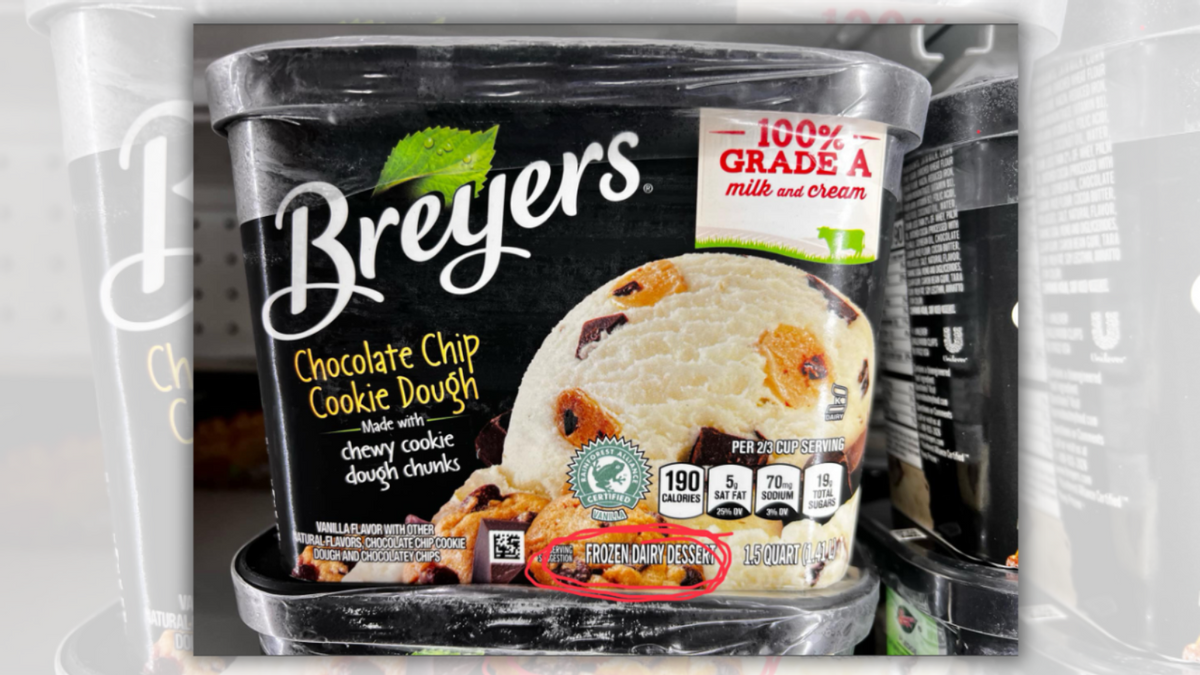Fact Check: We Looked Into the Claim that Breyer's Ice Cream Is Now Called 'Frozen Dessert' Because It's 50% Air

Claim:
Breyer's ice cream is required by law to be labeled "frozen dessert" because it's at least 50% air.
Rating:
Context:
Breyer's sells both ice cream and frozen dairy desserts. The difference between the two products is not due to proportion of air whipped into the product, but due to the percentage of milk fat used in it. Legally, in the United States, ice cream contains 10% or more milk fat — per the FDA — while frozen desserts contain less.
In May 2024, a post on Facebook claimed that ice cream manufacturer Breyer's no longer sold ice cream, but "frozen dairy desserts," as it failed to meet standards of quality for ice cream set by the Food and Drug Administration (FDA):
Breyer's, America's favorite ice cream, is no longer ice cream. It now legally has to be called Frozen Dessert, as it is 50% air, and has only a tiny percentage of actual milk or cream.
https://www.facebook.com/tim.kenney.dc/posts/pfbid02vEBQox2sRaNm7NgEY22TvVVnHBEVQgYFC4MCbsPjpHdq1JSfeiNGEfbWF5n2yWogl
The post had garnered 1,600 reactions and had been shared more than 35,000 times as of this writing. A post with the exact same wording also appeared on a forum of Orange Tractor Talks.
In fact, Breyer's makes and sells both ice cream and frozen dairy desserts. The two products belong to separate legal categories established by the FDA.
U.S. Standards
According to the § 58.2825 United States standard for ice cream on the website of the U.S. Department of Agriculture (USDA):
(a) Ice cream shall contain at least 1.6 pounds of total solids to the gallon, weigh not less than 4.5 pounds to the gallon, and contain not less than 20 percent total milk solids, constituted of not less than 10 percent milkfat. In no case shall the content of milk solids not fat be less than 6 percent. Whey shall not, by weight, be more than 25 percent of the milk solids not fat.
We find the exact same text on the website of of the FDA under part 135, section 135.110.
While Breyer's products are made of "grade A milk and cream," they just use less of these, relying instead on "overrun" — the technical term for air whipped into the cream — to give volume to their desserts. This is not new. It probably happened for cost-cutting reasons — though Breyer's never acknowledged this. In 2015, a television reporter for Fox13 in Tampa Bay did a taste test and investigated the reasons for this subtle difference between "ice cream" and "frozen dairy dessert." After his wife and he bought two tubs that were the same size and the same price, here's what he noticed (emphasis ours):
A spokesperson explained that the Food and Drug Administration requires ice cream to contain at least 10% milk fat. Otherwise, it cannot be named ice cream.
So, a tasty frozen carton such as my mint Oreo can look like ice cream, taste like ice cream, and contain 9.99999% milk fat, but cannot legally be called ice cream.
(...)
We asked Breyers about the difference between these two. In a broadly worded statement, it said, "Both Breyers' Frozen Dairy Dessert and Ice Cream products start with cream, sugar and milk, but in different proportions."
Further, the FDA requires less than 100% whipped air for a product to qualify as ice cream. Per industry standards, however, the "premium" and "super premium" ice creams should contain 50% or less. The tubs for those are heavier for the same volume.
But the FDA rule isn't necessarily a mark of quality. For example, the word "gelato" does not have a legal definition in the U.S. — in fact, the traditional recipe for Italian gelato does not contain enough fat to qualify as ice cream by FDA rules. Per Italian rules, gelato (which is the Italian word for ice cream) must contain at least 3.5% milk fat, far below the U.S. standard.
In 2021, we fact-checked a story that Breyer's was labeled differently in the U.S. and Canada. In 2016, we addressed fears that Breyer's ice cream failure to melt indicated that the products were unsafe to consume.
Sources:
CFR - Code of Federal Regulations Title 21. https://www.accessdata.fda.gov/scripts/cdrh/cfdocs/cfcfr/cfrsearch.cfm?fr=135.110. Accessed 20 May 2024.
Evon, Dan. 'FACT CHECK: Does Breyers Ice Cream Not Melt?' Snopes, 16 May 2016, https://www.snopes.com//fact-check/breyers-ice-cream-melt/.
'"Frozen Dairy Dessert" vs. Ice Cream'. FOX 13 News, 2 Sept. 2015, https://www.fox13news.com/news/frozen-dairy-dessert-vs-ice-cream.
Gelato vs Ice Cream - Difference and Comparison | Diffen. https://www.diffen.com/difference/Gelato_vs_Ice_Cream. Accessed 20 May 2024.
Ibrahim, Nur. 'Is Breyers Labeled "Frozen Dessert" in Canada, Not Ice Cream?' Snopes, 22 June 2021, https://www.snopes.com//fact-check/breyers-frozen-dessert-ice-cream/.
Ice Cream Standard | Agricultural Marketing Service. https://www.ams.usda.gov/grades-standards/ice-cream. Accessed 20 May 2024.
Staff, Tasting Table. 'Ice Cream Vs. Gelato: What's The Difference?' Tasting Table, 12 Sept. 2017, https://www.tastingtable.com/695371/difference-between-ice-cream-gelato-sherbet-sorbet-frozen-desserts/.
'The One Ice Cream Metric That Matters to Grocers (Hint: It's Not Butterfat)'. Kitchn, https://www.thekitchn.com/the-one-ice-cream-metric-that-matters-to-grocers-hint-its-not-butterfat-231918. Accessed 20 May 2024.



